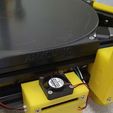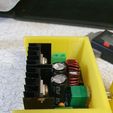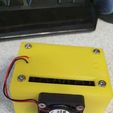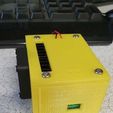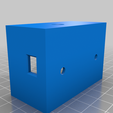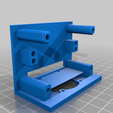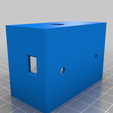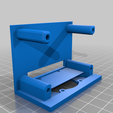3D model description
I fitted a neopixel LED ring to illuminate my printing and offer a bit of colour to the printer with some useful functionality. However, the original little buck converter seemed to be getting quite hot considering the lowish power being consumed so I thought I'd upgrade the 5 volt supply for the LED's.
This case has a pair of countersunk mounting holes in the base and will fit on pretty much any surface. It mounts on 2020 extrusion on my Kossel Linear Plus. The case has a fan and a labyrinth design air path which draws air positively across the face of the heat sinks. It is designed to use a 30mm 5 volt fan which provides decent amount of air movement with very little noise. So far in use, the heatsinks are barely warm even after prolonged prints of 18 hours or more with the Neopixel ring running flat out in white colour.
The case is designed to have an option where the fan takes its power from a pair of pogo pins mounted in the lid. This removes the requirement to disconnect the fan wires when removing the cover for maintenance. The adjuster knob shaft can be covered with a cap to prevent inadvertent movement. A case design with a threaded hole for the cap is optional, as is the lid with the pogo pin holes if you wish to power the fan from other sources. I put holes in each end so a 12 volt fan could be used too, or they can be used to gain access to the terminal screws without lid removal, if no pogo pins used.
Hope someone finds it useful. There's a plethora of these buck converter cases out there but I thought I'd chuck my design into the mix as I've not found one for this particular circuit board. Parts list below:
Buck converter WINGONEER XL4016E1 DC 4-40V to DC 1.25-36V 8A Buck Converter : https://www.amazon.co.uk/gp/product/B071L34ZXB/ref=ppx_yo_dt_b_asin_title_o04_s00?ie=UTF8&psc=1
13mm long pogo pins, 2.5mm dia with 3.5mm shoulder. (Optional) https://www.ebay.co.uk/c/900472179
30mm 5 volt "Pi-Fan" https://www.amazon.co.uk/gp/product/B071JN6HKM/ref=ppx_yo_dt_b_asin_title_o08_s00?ie=UTF8&psc=1
You will also need four x M3 x 30mm cap head screws and four x M3 x 8mm mushroom or cap head to secure the fan. I've got a selection of fasteners so you can source these from anywhere.
Post-Printing
Assembly Instructions
Clean up the threaded holes before assembly by running the correct size screws down the holes. The lid securing screws only have a few mm to bite into the base threaded holes so ensure they're cleaned out as they can strip quite easily.
If you choose the pogo pinned option, the best way I found was to snip off the dupont connectors from the fan wires as close as possible to the ends. (There's not a hugely generous amount of cable on these fans). Strip about 2mm and tin the ends with solder. Also carefully tin the back end of the pogo pins, ensuring no solder runs down the sides. Thread the wires through the holes in the lid from the outside in, ensuring the polarity is correct. The positive wire needs to go through the hole furthest away from the heatsink air intake. Once passed through the lid, carefully solder to the backs of the pogo pins, ensuring once again that there is no overhang to the outside diameter. The pogo pins can then be pushed back into their recesses. If they're a bit tight, use the head of a M3 caphead screw over the spring pin so it rests on the shoulder of the pin and tap home with a small hammer. The shoulder should fit flush with the end of its housing once done. The fan can now be fitted to the lid using the four 8mm screws. Make sure the fan is orientated to draw air from the case, not blow it in. It's much more efficient this way.
Secure the case to the mounting surface using M4 countersunk headed screws before fitting the buck converter to the case. Once the case is mounted, fit the buck converter by passing the adjuster knob shaft through the hole and push down to seat the circuit board onto the corner pads. connect the input and before connecting the output wires to the terminals, measure the output voltage and adjust as necessary before fitting the lid. The cover can be printed and fitted over the knob shaft to prevent tampering if required but you'll require the threaded hole version of the base to allow this to be fitted.
3D printing settings
Print Settings
Printer brand:
Anycubic
Printer:
Kossel
Supports:
Yes
Resolution:
0.2mm
Infill:
30%
Filament brand:
Technology outlet
Filament color:
Yellow
Filament material:
PLA
Notes:
I printed the cover upside down and used supports from buildplate to keep the cap head screw recesses clean. The base can be printed upright with supports everywhere which helps keep the terminal holes from drooping if your printer isn't good at bridging.

/https://fbi.cults3d.com/uploaders/14813950/illustration-file/69b97272-60d0-46f0-a137-b918e3e03909/20200626_115114.jpg)
